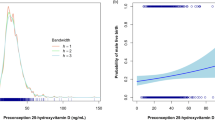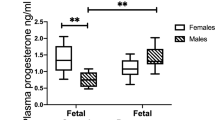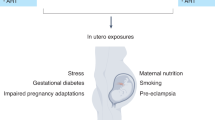The timing of a mouse's first litter influences the development of her pups.
Abstract
We have investigated the effect of the age at first pregnancy in mice on maternal steroid hormone levels and how these influence the growth and sexual maturation of their pups. We find that early-adolescent and middle-aged pregnant mice have less serum oestradiol and a different pattern of serum testosterone compared with young-adult pregnant mice. Grown offspring of early-adolescent and middle-aged mothers have lower body weight and delayed puberty, and males have smaller reproductive organs than those produced by young adults. Female offspring themselves produce pups whose birthweight depends on the age at pregnancy of their grandmothers. Changes in a female's physiology during ageing can thus alter the growth and reproductive traits not only of her own offspring but also of subsequent generations.
This is a preview of subscription content, access via your institution
Access options
Subscribe to this journal
Receive 51 print issues and online access
$199.00 per year
only $3.90 per issue
Buy this article
- Purchase on Springer Link
- Instant access to full article PDF
Prices may be subject to local taxes which are calculated during checkout

Similar content being viewed by others
References
vom Saal, F. S. J. Anim. Sci. 67, 1824–1840 (1989).
Howdeshell, K. L., Hotchkiss, A. K., Thayer, K. A., Vandenbergh, J. G. & vom Saal, F. S. Nature 401, 763–764 (1999).
Clutton-Brock, T. H. (ed.) Reproductive Success: Studies of Individual Variation in Contrasting Breeding Systems (Univ. Chicago Press, Chicago, 1988 ).
vom Saal, F. S., Finch, C. E. & Nelson, J. F. in Physiology of Reproduction Vol. 2 (eds Knobil, E., Neill, J. & Pfaff, D.) 1213–1314 (Raven, New York, 1994).
Finch, C. E. & Kirkwood, T. B. L. Chance, Development, and Aging (Oxford Univ. Press, 2000).
Matt, D. W., Lee, J., Sarver, P. L., Judd, H. L. & Lu, J. K. H. Biol. Reprod. 34, 478– 487 (1986).
Bernstein, L. et al. J. Natl Cancer Inst. 76, 1035– 1039 (1986).
Bernstein, L. et al. Br. J. Cancer 58, 379– 381 (1988).
Key, T. et al. Br. J. Cancer 73, 698–701 (1996).
Holliday, R. Science 238, 163–170 ( 1987).
vom Saal, F. S. et al. Proc. Natl Acad. Sci. USA 94, 2056– 2061 (1997).
Author information
Authors and Affiliations
Corresponding author
Rights and permissions
About this article
Cite this article
Wang, MH., vom Saal, F. Maternal age and traits in offspring. Nature 407, 469–470 (2000). https://doi.org/10.1038/35035156
Issue Date:
DOI: https://doi.org/10.1038/35035156
This article is cited by
Comments
By submitting a comment you agree to abide by our Terms and Community Guidelines. If you find something abusive or that does not comply with our terms or guidelines please flag it as inappropriate.



